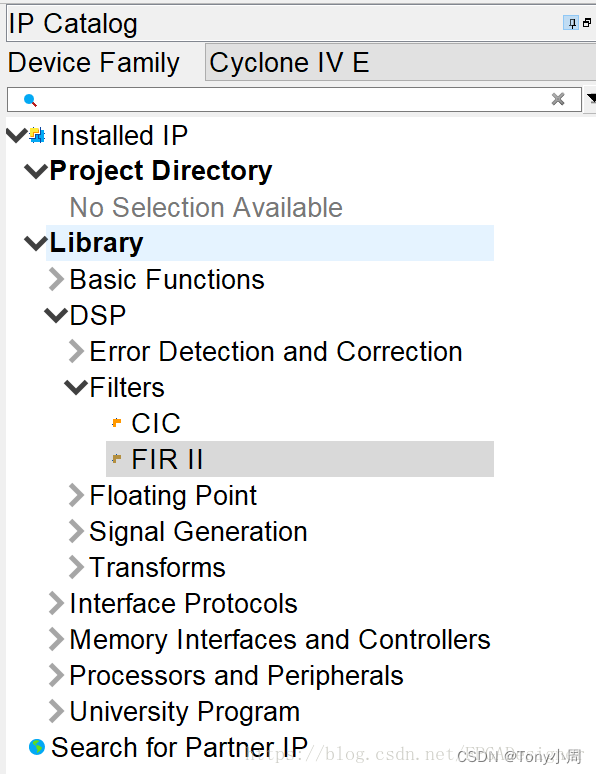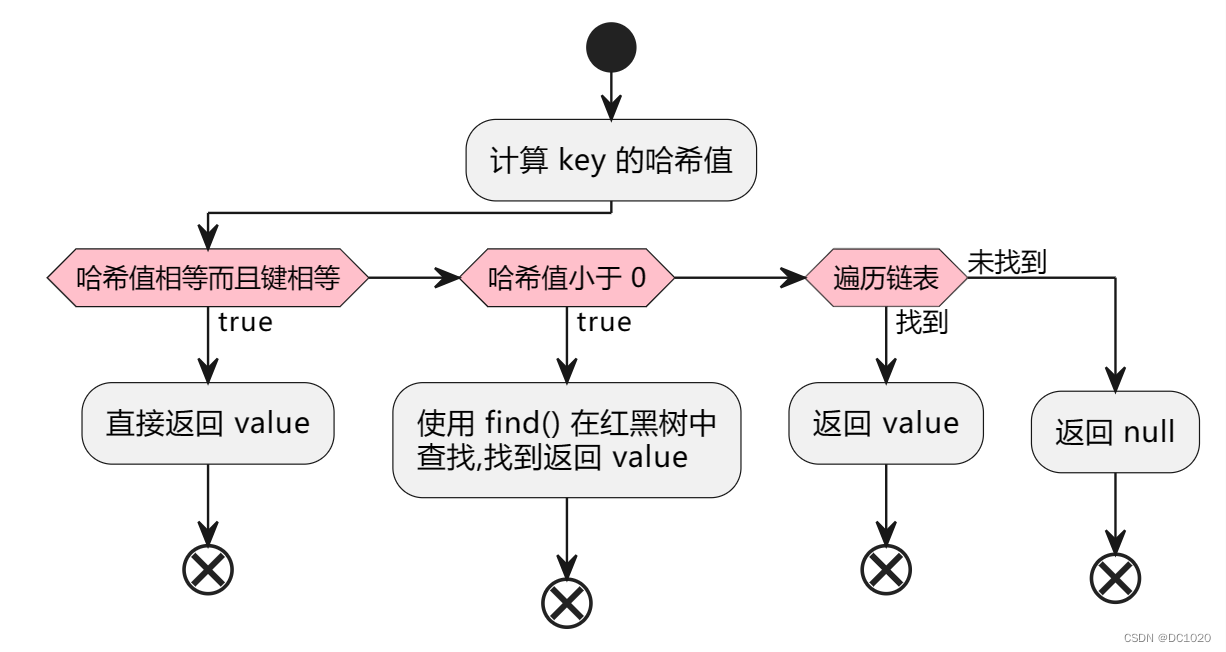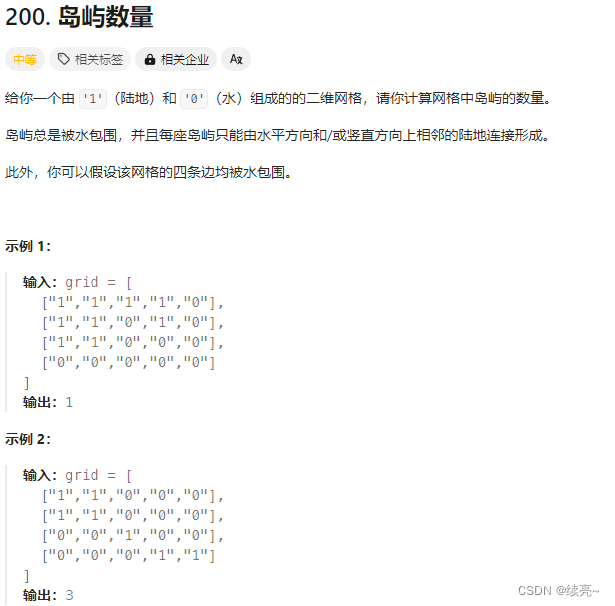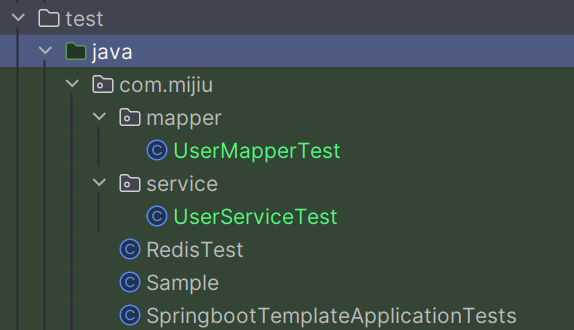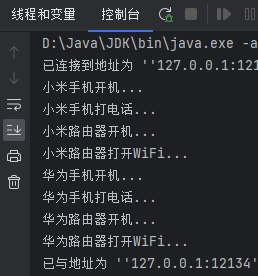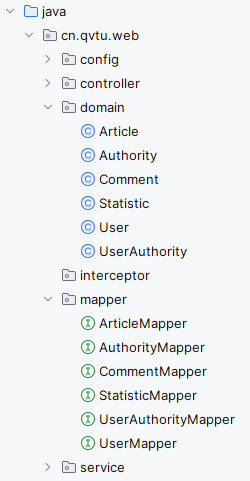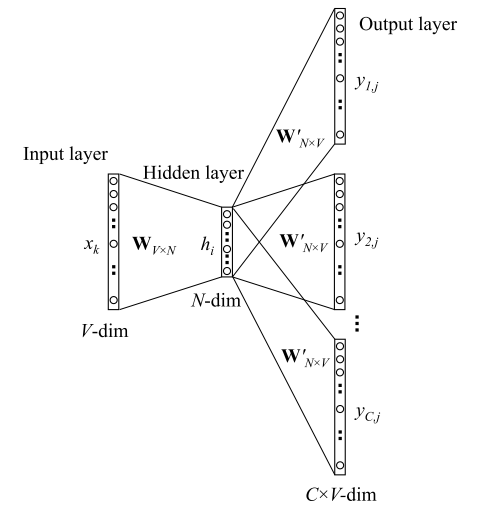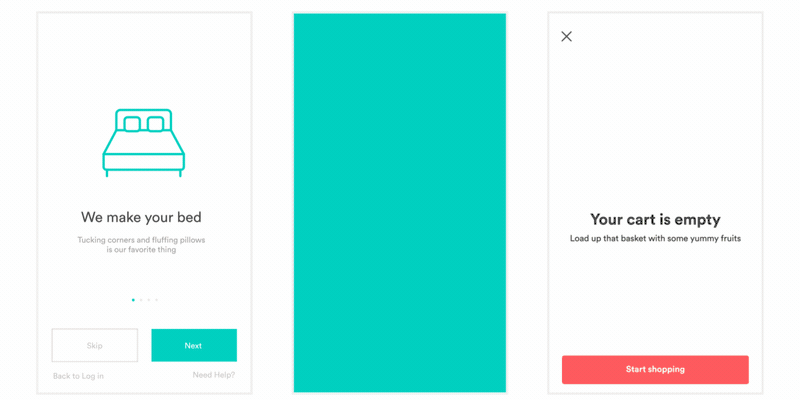Android14 - WindowManagerService之客户端Activity布局
一、主要角色
WMS作为一个服务端,有多种客户端与其交互的场景。我们以常见的Activity为例:

Activity:在ActivityThread构建一个Activity后,会调用其attach方法,在attach中构建了一个PhoneWindow。
PhoneWindow:一个Activity对应一个PhoneWindow。而每个PhoneWindow持有一个WindowManagerImpl对象。
WindowManagerImpl:是服务端WMS在客户端的代理。而WindowManagerImpl中持有WindowManagerGlobal。
WindowManagerGlobal:是进程内的单例。WindowManagerGlobal不仅持有WMS服务端的WindowManagerService、WindowSession的引用,并且集合了所有的ViewRootImpl、DecorView等
ViewRootImpl:每个Activity对应一个ViewRootImp对象。ViewRootImp是作为客户端与WMS的桥梁。从客户端到服务端的角度,ViewRootImp中持有的WindowSession对象是服务端Session的引用,一个Session对应一个window。从服务端到客户端的角度,ViewRootImp中有一个子类W,是binder通信的服务端,W对象的引用被WMS持有,用来服务端向客户端通信。另外,ViewRootImp中持有DecorView对象。从逻辑上,ViewRootImpl是View树的根,但其本身并不是一个View,只是实现了ViewParent接口。DecorView是ViewRootImp的子类(见setView()方法中的view.assignParent(this))
)
DecorView:每个Activity对应一个DecorView。DecorView是真正的顶层View,是最外层的view。其inflate PhoneWidow传过来的layout后,将其addView作为自己的第0个类。DecorView维护了一个窗口的基本结构,包括主内容区域、titlebar区域等。
二、窗口的构建过程
窗口的结构大致如下:
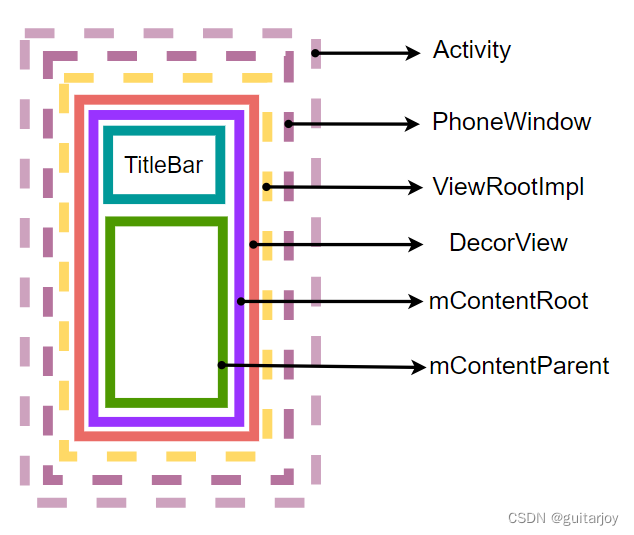
其过程参考上图,在PhoneWindow的初始化过程中,调用了generateLayout(DecorView decor)方法,其中对一个window的整体画面进行了初始化。
protected ViewGroup generateLayout(DecorView decor) {
// Apply data from current theme.
// Style来自于Theme xml文件
TypedArray a = getWindowStyle();
mIsFloating = a.getBoolean(R.styleable.Window_windowIsFloating, false);
int flagsToUpdate = (FLAG_LAYOUT_IN_SCREEN|FLAG_LAYOUT_INSET_DECOR)
& (~getForcedWindowFlags());
if (mIsFloating) {
setLayout(WRAP_CONTENT, WRAP_CONTENT);
setFlags(0, flagsToUpdate);
} else {
setFlags(FLAG_LAYOUT_IN_SCREEN|FLAG_LAYOUT_INSET_DECOR, flagsToUpdate);
getAttributes().setFitInsetsSides(0);
getAttributes().setFitInsetsTypes(0);
}
if (a.getBoolean(R.styleable.Window_windowNoTitle, false)) {
requestFeature(FEATURE_NO_TITLE);
} else if (a.getBoolean(R.styleable.Window_windowActionBar, false)) {
// Don't allow an action bar if there is no title.
requestFeature(FEATURE_ACTION_BAR);
}
if (a.getBoolean(R.styleable.Window_windowActionBarOverlay, false)) {
requestFeature(FEATURE_ACTION_BAR_OVERLAY);
}
if (a.getBoolean(R.styleable.Window_windowActionModeOverlay, false)) {
requestFeature(FEATURE_ACTION_MODE_OVERLAY);
}
if (a.getBoolean(R.styleable.Window_windowFullscreen, false)) {
setFlags(FLAG_FULLSCREEN, FLAG_FULLSCREEN & (~getForcedWindowFlags()));
}
if (a.getBoolean(R.styleable.Window_windowTranslucentStatus,
false)) {
setFlags(FLAG_TRANSLUCENT_STATUS, FLAG_TRANSLUCENT_STATUS
& (~getForcedWindowFlags()));
}
if (a.getBoolean(R.styleable.Window_windowTranslucentNavigation,
false)) {
setFlags(FLAG_TRANSLUCENT_NAVIGATION, FLAG_TRANSLUCENT_NAVIGATION
& (~getForcedWindowFlags()));
}
if (a.getBoolean(R.styleable.Window_windowShowWallpaper, false)) {
setFlags(FLAG_SHOW_WALLPAPER, FLAG_SHOW_WALLPAPER&(~getForcedWindowFlags()));
}
if (a.getBoolean(R.styleable.Window_windowEnableSplitTouch,
getContext().getApplicationInfo().targetSdkVersion
>= android.os.Build.VERSION_CODES.HONEYCOMB)) {
setFlags(FLAG_SPLIT_TOUCH, FLAG_SPLIT_TOUCH&(~getForcedWindowFlags()));
}
a.getValue(R.styleable.Window_windowMinWidthMajor, mMinWidthMajor);
a.getValue(R.styleable.Window_windowMinWidthMinor, mMinWidthMinor);
if (DEBUG) Log.d(TAG, "Min width minor: " + mMinWidthMinor.coerceToString()
+ ", major: " + mMinWidthMajor.coerceToString());
if (a.hasValue(R.styleable.Window_windowFixedWidthMajor)) {
if (mFixedWidthMajor == null) mFixedWidthMajor = new TypedValue();
a.getValue(R.styleable.Window_windowFixedWidthMajor,
mFixedWidthMajor);
}
if (a.hasValue(R.styleable.Window_windowFixedWidthMinor)) {
if (mFixedWidthMinor == null) mFixedWidthMinor = new TypedValue();
a.getValue(R.styleable.Window_windowFixedWidthMinor,
mFixedWidthMinor);
}
if (a.hasValue(R.styleable.Window_windowFixedHeightMajor)) {
if (mFixedHeightMajor == null) mFixedHeightMajor = new TypedValue();
a.getValue(R.styleable.Window_windowFixedHeightMajor,
mFixedHeightMajor);
}
if (a.hasValue(R.styleable.Window_windowFixedHeightMinor)) {
if (mFixedHeightMinor == null) mFixedHeightMinor = new TypedValue();
a.getValue(R.styleable.Window_windowFixedHeightMinor,
mFixedHeightMinor);
}
if (a.getBoolean(R.styleable.Window_windowContentTransitions, false)) {
requestFeature(FEATURE_CONTENT_TRANSITIONS);
}
if (a.getBoolean(R.styleable.Window_windowActivityTransitions, false)) {
requestFeature(FEATURE_ACTIVITY_TRANSITIONS);
}
mIsTranslucent = a.getBoolean(R.styleable.Window_windowIsTranslucent, false);
final Context context = getContext();
final int targetSdk = context.getApplicationInfo().targetSdkVersion;
final boolean targetPreL = targetSdk < android.os.Build.VERSION_CODES.LOLLIPOP;
final boolean targetPreQ = targetSdk < Build.VERSION_CODES.Q;
if (!mForcedStatusBarColor) {
mStatusBarColor = a.getColor(R.styleable.Window_statusBarColor, Color.BLACK);
}
if (!mForcedNavigationBarColor) {
final int navBarCompatibleColor = context.getColor(R.color.navigation_bar_compatible);
final int navBarDefaultColor = context.getColor(R.color.navigation_bar_default);
final int navBarColor = a.getColor(R.styleable.Window_navigationBarColor,
navBarDefaultColor);
mNavigationBarColor =
navBarColor == navBarDefaultColor
&& !context.getResources().getBoolean(
R.bool.config_navBarDefaultTransparent)
? navBarCompatibleColor
: navBarColor;
mNavigationBarDividerColor = a.getColor(R.styleable.Window_navigationBarDividerColor,
Color.TRANSPARENT);
}
if (!targetPreQ) {
mEnsureStatusBarContrastWhenTransparent = a.getBoolean(
R.styleable.Window_enforceStatusBarContrast, false);
mEnsureNavigationBarContrastWhenTransparent = a.getBoolean(
R.styleable.Window_enforceNavigationBarContrast, true);
}
WindowManager.LayoutParams params = getAttributes();
// Non-floating windows on high end devices must put up decor beneath the system bars and
// therefore must know about visibility changes of those.
if (!mIsFloating) {
if (!targetPreL && a.getBoolean(
R.styleable.Window_windowDrawsSystemBarBackgrounds,
false)) {
setFlags(FLAG_DRAWS_SYSTEM_BAR_BACKGROUNDS,
FLAG_DRAWS_SYSTEM_BAR_BACKGROUNDS & ~getForcedWindowFlags());
}
if (mDecor.mForceWindowDrawsBarBackgrounds) {
params.privateFlags |= PRIVATE_FLAG_FORCE_DRAW_BAR_BACKGROUNDS;
}
params.privateFlags |= PRIVATE_FLAG_NO_MOVE_ANIMATION;
}
if (a.getBoolean(
R.styleable.Window_windowNoMoveAnimation,
false)) {
params.privateFlags |= PRIVATE_FLAG_NO_MOVE_ANIMATION;
}
final int sysUiVis = decor.getSystemUiVisibility();
final int statusLightFlag = View.SYSTEM_UI_FLAG_LIGHT_STATUS_BAR;
final int statusFlag = a.getBoolean(R.styleable.Window_windowLightStatusBar, false)
? statusLightFlag : 0;
final int navLightFlag = View.SYSTEM_UI_FLAG_LIGHT_NAVIGATION_BAR;
final int navFlag = a.getBoolean(R.styleable.Window_windowLightNavigationBar, false)
? navLightFlag : 0;
decor.setSystemUiVisibility(
(sysUiVis & ~(statusLightFlag | navLightFlag)) | (statusFlag | navFlag));
if (a.hasValue(R.styleable.Window_windowLayoutInDisplayCutoutMode)) {
int mode = a.getInt(R.styleable.Window_windowLayoutInDisplayCutoutMode, -1);
if (mode < LAYOUT_IN_DISPLAY_CUTOUT_MODE_DEFAULT
|| mode > LAYOUT_IN_DISPLAY_CUTOUT_MODE_ALWAYS) {
throw new UnsupportedOperationException("Unknown windowLayoutInDisplayCutoutMode: "
+ a.getString(R.styleable.Window_windowLayoutInDisplayCutoutMode));
}
params.layoutInDisplayCutoutMode = mode;
}
if (mAlwaysReadCloseOnTouchAttr || getContext().getApplicationInfo().targetSdkVersion
>= android.os.Build.VERSION_CODES.HONEYCOMB) {
if (a.getBoolean(
R.styleable.Window_windowCloseOnTouchOutside,
false)) {
setCloseOnTouchOutsideIfNotSet(true);
}
}
if (!hasSoftInputMode()) {
params.softInputMode = a.getInt(
R.styleable.Window_windowSoftInputMode,
params.softInputMode);
}
if (a.getBoolean(R.styleable.Window_backgroundDimEnabled,
mIsFloating)) {
/* All dialogs should have the window dimmed */
if ((getForcedWindowFlags()&WindowManager.LayoutParams.FLAG_DIM_BEHIND) == 0) {
params.flags |= WindowManager.LayoutParams.FLAG_DIM_BEHIND;
}
if (!haveDimAmount()) {
params.dimAmount = a.getFloat(
android.R.styleable.Window_backgroundDimAmount, 0.5f);
}
}
if (a.getBoolean(R.styleable.Window_windowBlurBehindEnabled, false)) {
if ((getForcedWindowFlags() & WindowManager.LayoutParams.FLAG_BLUR_BEHIND) == 0) {
params.flags |= WindowManager.LayoutParams.FLAG_BLUR_BEHIND;
}
params.setBlurBehindRadius(a.getDimensionPixelSize(
android.R.styleable.Window_windowBlurBehindRadius, 0));
}
setBackgroundBlurRadius(a.getDimensionPixelSize(
R.styleable.Window_windowBackgroundBlurRadius, 0));
if (params.windowAnimations == 0) {
params.windowAnimations = a.getResourceId(
R.styleable.Window_windowAnimationStyle, 0);
}
// The rest are only done if this window is not embedded; otherwise,
// the values are inherited from our container.
if (getContainer() == null) {
if (mBackgroundDrawable == null) {
if (mFrameResource == 0) {
mFrameResource = a.getResourceId(R.styleable.Window_windowFrame, 0);
}
if (a.hasValue(R.styleable.Window_windowBackground)) {
mBackgroundDrawable = a.getDrawable(R.styleable.Window_windowBackground);
}
}
if (a.hasValue(R.styleable.Window_windowBackgroundFallback)) {
mBackgroundFallbackDrawable =
a.getDrawable(R.styleable.Window_windowBackgroundFallback);
}
if (mLoadElevation) {
mElevation = a.getDimension(R.styleable.Window_windowElevation, 0);
}
mClipToOutline = a.getBoolean(R.styleable.Window_windowClipToOutline, false);
mTextColor = a.getColor(R.styleable.Window_textColor, Color.TRANSPARENT);
}
// Inflate the window decor.
// 根据Feature的设置,选择不同的layout xml。具体的resource来源于platform/frameworks/base/core/res/res,根据不同平台选择具体的资源文件。
// 如果什么都没有设置,最后默认的会选择R.layout.screen_simple;
int layoutResource;
int features = getLocalFeatures();
// System.out.println("Features: 0x" + Integer.toHexString(features));
if ((features & ((1 << FEATURE_LEFT_ICON) | (1 << FEATURE_RIGHT_ICON))) != 0) {
if (mIsFloating) {
TypedValue res = new TypedValue();
getContext().getTheme().resolveAttribute(
R.attr.dialogTitleIconsDecorLayout, res, true);
layoutResource = res.resourceId;
} else {
layoutResource = R.layout.screen_title_icons;
}
// XXX Remove this once action bar supports these features.
removeFeature(FEATURE_ACTION_BAR);
// System.out.println("Title Icons!");
} else if ((features & ((1 << FEATURE_PROGRESS) | (1 << FEATURE_INDETERMINATE_PROGRESS))) != 0
&& (features & (1 << FEATURE_ACTION_BAR)) == 0) {
// Special case for a window with only a progress bar (and title).
// XXX Need to have a no-title version of embedded windows.
layoutResource = R.layout.screen_progress;
// System.out.println("Progress!");
} else if ((features & (1 << FEATURE_CUSTOM_TITLE)) != 0) {
// Special case for a window with a custom title.
// If the window is floating, we need a dialog layout
if (mIsFloating) {
TypedValue res = new TypedValue();
getContext().getTheme().resolveAttribute(
R.attr.dialogCustomTitleDecorLayout, res, true);
layoutResource = res.resourceId;
} else {
layoutResource = R.layout.screen_custom_title;
}
// XXX Remove this once action bar supports these features.
removeFeature(FEATURE_ACTION_BAR);
} else if ((features & (1 << FEATURE_NO_TITLE)) == 0) {
// If no other features and not embedded, only need a title.
// If the window is floating, we need a dialog layout
if (mIsFloating) {
TypedValue res = new TypedValue();
getContext().getTheme().resolveAttribute(
R.attr.dialogTitleDecorLayout, res, true);
layoutResource = res.resourceId;
} else if ((features & (1 << FEATURE_ACTION_BAR)) != 0) {
layoutResource = a.getResourceId(
R.styleable.Window_windowActionBarFullscreenDecorLayout,
R.layout.screen_action_bar);
} else {
layoutResource = R.layout.screen_title;
}
// System.out.println("Title!");
} else if ((features & (1 << FEATURE_ACTION_MODE_OVERLAY)) != 0) {
layoutResource = R.layout.screen_simple_overlay_action_mode;
} else {
// Embedded, so no decoration is needed.
layoutResource = R.layout.screen_simple;
// System.out.println("Simple!");
}
mDecor.startChanging();
// 将最终的layoutResource传给DecorView,在DecorView里面去inflate
mDecor.onResourcesLoaded(mLayoutInflater, layoutResource);
ViewGroup contentParent = (ViewGroup)findViewById(ID_ANDROID_CONTENT);
if (contentParent == null) {
throw new RuntimeException("Window couldn't find content container view");
}
if ((features & (1 << FEATURE_INDETERMINATE_PROGRESS)) != 0) {
ProgressBar progress = getCircularProgressBar(false);
if (progress != null) {
progress.setIndeterminate(true);
}
}
// Remaining setup -- of background and title -- that only applies
// to top-level windows.
if (getContainer() == null) {
mDecor.setWindowBackground(mBackgroundDrawable);
final Drawable frame;
if (mFrameResource != 0) {
frame = getContext().getDrawable(mFrameResource);
} else {
frame = null;
}
mDecor.setWindowFrame(frame);
mDecor.setElevation(mElevation);
mDecor.setClipToOutline(mClipToOutline);
if (mTitle != null) {
setTitle(mTitle);
}
if (mTitleColor == 0) {
mTitleColor = mTextColor;
}
setTitleColor(mTitleColor);
}
mDecor.finishChanging();
return contentParent;
}
该方法做了几件事:
1. 获取主题属性。TypedArray a = getWindowStyle();
getWindowStyle最终调用的是
platform/frameworks/base/core/java/android/content/Context.java
@NonNull
public final TypedArray obtainStyledAttributes(@NonNull @StyleableRes int[] attrs) {
return getTheme().obtainStyledAttributes(attrs);
}Theme获取根据不同平台、版本返回不同的文件:
platform/frameworks/base/core/java/android/content/res/Resources.java
@UnsupportedAppUsage
public static int selectDefaultTheme(int curTheme, int targetSdkVersion) {
return selectSystemTheme(curTheme, targetSdkVersion,
com.android.internal.R.style.Theme,
com.android.internal.R.style.Theme_Holo,
com.android.internal.R.style.Theme_DeviceDefault,
com.android.internal.R.style.Theme_DeviceDefault_Light_DarkActionBar);
}
/** @hide */
public static int selectSystemTheme(int curTheme, int targetSdkVersion, int orig, int holo,
int dark, int deviceDefault) {
if (curTheme != ID_NULL) {
return curTheme;
}
if (targetSdkVersion < Build.VERSION_CODES.HONEYCOMB) {
return orig;
}
if (targetSdkVersion < Build.VERSION_CODES.ICE_CREAM_SANDWICH) {
return holo;
}
if (targetSdkVersion < Build.VERSION_CODES.N) {
return dark;
}
return deviceDefault;
}对应的是platform/frameworks/base/core/res/res/values/themes.xml、platform/frameworks/base/core/res/res/values/themes_holo.xml、platform/frameworks/base/core/res/res/values/themes_device_defaults.xml等等这些主题文件。
2. 根据theme里的配置,设置feature、flags、背景色等。
3. 根据设置后的feature,选择一个layout文件layoutResource。该layoutResource传给DecorView进行窗口View构建。
一般layout都分为上面的titlebar的区域,和下面的content主区域。titlebar部分的区域不是固定的,每个layout可能有不同的布局。content一般是固定的。就是说大部分layout都会有一个id为content的layout。
以默认的platform/frameworks/base/core/res/res/layout/screen_simple.xml文件为例:
<LinearLayout xmlns:android="http://schemas.android.com/apk/res/android"
android:layout_width="match_parent"
android:layout_height="match_parent"
android:fitsSystemWindows="true"
android:orientation="vertical">
<ViewStub android:id="@+id/action_mode_bar_stub"
android:inflatedId="@+id/action_mode_bar"
android:layout="@layout/action_mode_bar"
android:layout_width="match_parent"
android:layout_height="wrap_content"
android:theme="?attr/actionBarTheme" />
<FrameLayout
android:id="@android:id/content"
android:layout_width="match_parent"
android:layout_height="match_parent"
android:foregroundInsidePadding="false"
android:foregroundGravity="fill_horizontal|top"
android:foreground="?android:attr/windowContentOverlay" />
</LinearLayout>action_mode_bar_stub是title的部分。
@android:id/content是主内容区域。对应的是PhoneWindow的mContentParent成员。
而整个布局对应的是DecorView的mContentRoot成员变量,在mContentRoot构建后,也被add到DecorView的第0个Child。具体
platform/frameworks/base/core/java/com/android/internal/policy/DecorView.java
void onResourcesLoaded(LayoutInflater inflater, int layoutResource) {
if (mBackdropFrameRenderer != null) {
loadBackgroundDrawablesIfNeeded();
mBackdropFrameRenderer.onResourcesLoaded(
this, mResizingBackgroundDrawable, mCaptionBackgroundDrawable,
mUserCaptionBackgroundDrawable, getCurrentColor(mStatusColorViewState),
getCurrentColor(mNavigationColorViewState));
}
mDecorCaptionView = createDecorCaptionView(inflater);
final View root = inflater.inflate(layoutResource, null);
if (mDecorCaptionView != null) {
if (mDecorCaptionView.getParent() == null) {
addView(mDecorCaptionView,
new ViewGroup.LayoutParams(MATCH_PARENT, MATCH_PARENT));
}
mDecorCaptionView.addView(root,
new ViewGroup.MarginLayoutParams(MATCH_PARENT, MATCH_PARENT));
} else {
// Put it below the color views.
addView(root, 0, new ViewGroup.LayoutParams(MATCH_PARENT, MATCH_PARENT));
}
mContentRoot = (ViewGroup) root;
initializeElevation();
}
